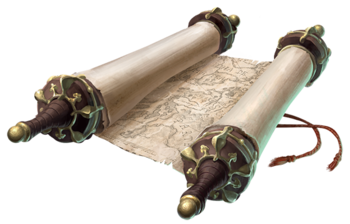Leader boards
Players will be able to opt-in to track certain achievements on leaderboards, such as.[1]
- Dungeons completed.[1][2]
- Raids completed.[1][2]
- PvP kills.[1]
- Caravans raided.[1]
- Gathering activity.[1]
Leaderboards may be seasonal.[2]
- We have many dreams that we want to do with game-to-web and game-to-mobile in regards to showing stats and being making things shareable for you. We know how social media works; how sharing content with friends works. But those things will come in due time.[1] – Margaret Krohn
Guild ladder
An inter-guild ladder will rank guilds based on their performance within competitive activities:[4][5]
When the guild participates in guild wars or they participate in sieges, you'll be able to climb the ranks of your inter-guild ladder as well so you get bragging rights amongst your friends.[5] – Steven Sharif
Arena ladder
The arena ladder system records a player's progress within PvP seasons based on their arena win/loss ratios.[7][8]
- Titles can be received from arena play.[9]
- Other rewards will be revealed at a later time.[10]
- Arena points that can be used to buy gear is not currently in the design.[9]
PvP seasons
Performance in various PvP systems (such as Caravans, Arenas, Guild wars) is measured over the course of 6 month PvP seasons. At the end of each season, a player's cumulative score may unlock various rewards.[7][11]
- Gear enhancement rewards.[11]
- Achievement ranks.[11]
- Purchasing power (Currency).[11]
- Potentially more granular player health bars.[12]
Metrics
Ashes of Creation gathers tracking data to facilitate achievements, titles and other accolades on a server.[13]
- Number of successful siege defenses.[13]
- Number of successful siege assaults.[13]
- Number of PvP kills.[14][13]
- Number of PvP deaths.[14]
- Raid participation points.[13]
- Number of firsts.[13]
Visibility of those types of things on the server help to promote a competitive atmosphere. If there is an attainable impression that you can work towards, so that others know your success, you have more drive to succeed.[13] – Steven Sharif
World history
The history of each server will be tracked and visible to players in a node's library.[16][17]
- This design may have changed.[18]
- We're gonna keep track of the history of the world so that we can tell people the story up to the current day. A player who's brand new, who's come in at the six-month mark can take a look at each server, what each server has done, how each server has tackled the storyline; and they can decide for themselves what community they want to join; what version of the world that they want to take part in.[17] – Jeffrey Bard
- Scribes may be able to collect and record information about the events of the world as they see it from their point of view.[19]
Memory fragments
Server-firsts within a server's story arc will be able to be captured and collected on memory fragments that players can collect in-game so they may relive their experiences.[20]
- We're going to leverage tech that captures at the moment when something server-first is done in the story arc; and those will be recorded on these memory fragments that players can collect within the game through their experiences and relive potentially.[20] – Steven Sharif
Libraries
At Village (stage 3) the academic node's unique building is the Library.[16]
- Information about the world will be presented directly to players through the world map UI.[18] Previously the Library was used to access information about the world, such as the history of significant narrative events, locations of gatherable resources, dungeons, and POIs.[16]
- In the past we talked about having a library that was capable of facilitating players exchanging information for map data like that, but we've moved a little bit more in a direction of just presenting that information up front to the player, because travel is such a meaningful portion of the game and we don't have fast travel. So, I think that for Alpha-2 what's planned is that we're going to be showcasing the intricate details of services offered at these node locations from just a UI presentation standpoint within the map.[18] – Steven Sharif
Players can use the Library to access information, including (but not limited to) the following:[16]
See also
References
- ↑ 1.0 1.1 1.2 1.3 1.4 1.5 1.6 Livestream, May 31, 2023 (2:21).
- ↑ 2.0 2.1 2.2 Livestream, July 18, 2017 (58:50).
- ↑ Livestream, May 15, 2017 (44:10).
- ↑ 4.0 4.1 4.2 4.3 Livestream, June 25, 2021 (1:12:37).
- ↑ 5.0 5.1 5.2 5.3 Interview, July 29, 2020 (14:28).
- ↑ Livestream, August 23, 2017 (16:44).
- ↑ 7.0 7.1 Livestream, September 24, 2021 (1:22:46).
- ↑

- ↑ 9.0 9.1 Podcast, May 11, 2018 (52:20).
- ↑

- ↑ 11.0 11.1 11.2 11.3 Interview, July 18, 2020 (16:34).
- ↑ Livestream, January 31, 2024 (59:45).
- ↑ 13.0 13.1 13.2 13.3 13.4 13.5 13.6 Podcast, August 4, 2018 (1:47:21).
- ↑ 14.0 14.1

- ↑ Kickstarter packages.
- ↑ 16.0 16.1 16.2 16.3 16.4 16.5 16.6 Blog: Know Your Nodes - Scientific Node Type
- ↑ 17.0 17.1 Interview, April 20, 2018 (9:20).
- ↑ 18.0 18.1 18.2 Livestream, September 29, 2023 (1:14:29).
- ↑ Livestream, May 26, 2017 (51:37).
- ↑ 20.0 20.1 Livestream, January 27, 2023 (4:18).


